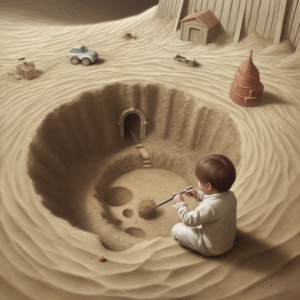In today’s increasingly diverse and inclusive society, understanding the distinctions between sex and gender is crucial. This blog post will explore the differences between these two terms often mistakenly seen as interchangeable, diving deep into their definitions and implications on our daily lives.
We’ will also discuss how biology and culture intertwine to mold our gender identities while debunking common myths that perpetuate harmful stereotypes.
 Key Takeaways
Key Takeaways
- Sex refers to an individual’s biological attributes such as chromosomes and reproductive organs, while gender encompasses their internal sense of being male, female, or beyond that spectrum.
- Gender is a social construct shaped by cultural norms and expectations, as well as personal identity expression. Society plays a significant role in shaping our perception of appropriate behavior for different sexes known as gender roles.
- Recognizing diverse gender identities is crucial in creating an inclusive society. Challenging harmful stereotypes will help create more opportunities for individuals with different sexual orientations/gender expressions while promoting universal freedom irrespective of one’s biological sex/identity expression.
Understanding The Difference Between Gender And Sex
Gender and sex are often used interchangeably, but they have distinct differences.
Defining Sex And Gender
Sex and Gender are often used interchangeably, but they have distinct meanings that play a significant role in shaping our understanding of ourselves and the world around us.
 In simple terms, sex refers to the biological differences between male and female individuals, including chromosomes (XX for females and XY for males), hormones (estrogen vs testosterone), reproductive organs, and other physical characteristics.
In simple terms, sex refers to the biological differences between male and female individuals, including chromosomes (XX for females and XY for males), hormones (estrogen vs testosterone), reproductive organs, and other physical characteristics.
On the other hand, gender encompasses an individual’s internal sense of being male, female or something else entirely—referred to as their gender identity—as well as how they express themselves socially through clothing choices, mannerisms or personal pronouns (gender expression).
Additionally, gender includes societal expectations about behaviors considered appropriate for different sexes known as gender roles which can contribute towards creating unwritten rules dictating what is acceptable behavior based on one’s perceived sex.
Highlighting The Differences Between The Two
One of the main distinctions between sex and gender lies in their basis: while sex is biologically determined, gender is a social construct. Sex refers to a person’s physical characteristics such as chromosomes (XX for female, XY for male), hormones (predominantly estrogen or testosterone), and reproductive organs.
 For instance, an individual born with XX chromosomes may identify as male despite being biologically female – emphasizing the significance of understanding that someone’s gender identity may not always align with their biological sex.
For instance, an individual born with XX chromosomes may identify as male despite being biologically female – emphasizing the significance of understanding that someone’s gender identity may not always align with their biological sex.
Exploring The Complexity Of Gender Identity
Gender identity is a deeply personal and intricate aspect of an individual’s sense of self. Unlike biological sex, which largely involves physical attributes such as chromosomes, hormones, and reproductive organs, gender identity encompasses a range of complex factors including psychological, emotional, and sociocultural dimensions.
One remarkable example that illustrates the complexity of gender identity is the existence of transgender individuals who may feel a strong disconnect between their assigned sex at birth and their internal sense of being male or female.
This misalignment can result in distress known as gender dysphoria which often prompts them to seek medical interventions like hormone therapy or surgeries for alignment with their true selves.
 Further complicating matters are numerous cultural nuances that dictate different interpretations of gender roles across societies around the world. In some cultures, third genders have long been accepted; examples include Hijras in South Asia and Two-Spirit Indigenous Americans who embody both masculine and feminine qualities simultaneously.
Further complicating matters are numerous cultural nuances that dictate different interpretations of gender roles across societies around the world. In some cultures, third genders have long been accepted; examples include Hijras in South Asia and Two-Spirit Indigenous Americans who embody both masculine and feminine qualities simultaneously.
How Biology And Culture Influence Gender Identity
Biology plays a role in shaping gender identity by determining our sex chromosomes and reproductive organs, while culture influences us through the socially constructed expectations of gender roles.
The Influence Of Biology On Gender Identity
Biology plays a significant role in shaping an individual’s gender identity. Biological factors such as hormones, genetics, and reproductive organs can influence how individuals perceive themselves in terms of their gender.
For instance, the presence or absence of certain sex chromosomes can determine whether an individual is male or female biologically.
 However, it’s important to note that while biology does contribute to gender identity formation, it’s not the only factor at play. Gender identity is also shaped by social and cultural factors like upbringing, societal expectations about gender roles and expressions, and individual experiences.
However, it’s important to note that while biology does contribute to gender identity formation, it’s not the only factor at play. Gender identity is also shaped by social and cultural factors like upbringing, societal expectations about gender roles and expressions, and individual experiences.
Social Factors That Shape Gender
Social factors play a significant role in shaping an individual’s gender identity. Here are some of the ways that society impacts our ideas of gender:
- Socialization: From a young age, children are socialized to behave and think in specific gendered ways. They learn what is considered “appropriate” behavior for their gender through interactions with parents, teachers, and peers.
- Media: Popular culture, media, and advertising often reinforce traditional gender roles and stereotypes. For example, women are frequently depicted as passive and emotional while men are portrayed as strong and rational.
- Language: The language we use can reinforce gender norms. For example, the use of “he” as a default pronoun assumes that everyone is male unless otherwise specified.

- Education: Educational institutions often reinforce traditional gender roles by offering different classes or extracurricular activities for boys and girls. This can limit opportunities for those who do not fit into these binary categories.
- discrimination: Individuals who do not conform to traditional gender norms may face discrimination in employment, education, healthcare, and other areas of life.
It is important to recognize the impact that social factors have on our understanding of gender. By questioning societal expectations and embracing inclusivity, we can create a more diverse and accepting world for all individuals regardless of how they identify.
The Role Of Culture In Shaping Gender
Culture plays a significant role in shaping gender identity. From birth, we are socialized into gender roles based on the cultural norms and expectations of our society. This is evident in the toys we play with, the clothes we wear, and even the way we speak.
Moreover, culture creates expectations about what it means to be masculine or feminine. These expectations influence how individuals perceive themselves and others. For example, women who exhibit traits traditionally associated with masculinity such as assertiveness may be viewed negatively by some cultures that prefer more submissive women.
 Ultimately, through various forms of socialization (such as media representation), culture perpetuates rigid gender stereotypes that can limit an individual’s sense of self-expression and acceptance for authenticity across different genders/sexualities expanding beyond the traditional binary definitions – this has led many marginalized groups to fight for representation within society at large – demonstrating a need for inclusivity where each person irrespective of their sexual orientation/gender expression should have equal opportunities without prejudice or discrimination based on their identities- which could foster a more tolerant world altogether promoting universal freedom!
Ultimately, through various forms of socialization (such as media representation), culture perpetuates rigid gender stereotypes that can limit an individual’s sense of self-expression and acceptance for authenticity across different genders/sexualities expanding beyond the traditional binary definitions – this has led many marginalized groups to fight for representation within society at large – demonstrating a need for inclusivity where each person irrespective of their sexual orientation/gender expression should have equal opportunities without prejudice or discrimination based on their identities- which could foster a more tolerant world altogether promoting universal freedom!
The Importance Of Recognizing Gender Diversity
Recognizing and celebrating gender diversity is crucial to creating a society that is inclusive and respectful of all individuals, regardless of their gender identity.
Highlighting Negative Impact Of Rigid Gender Stereotypes
Rigid gender stereotypes can have a significant impact on individuals and society as a whole. These stereotypes typically dictate how men and women should behave, what careers they should pursue, and even how they should dress.
 These stereotypes can lead to discrimination based on one’s gender identity or expression. It can also result in limited opportunities for individuals who don’t conform to these rigid expectations.
These stereotypes can lead to discrimination based on one’s gender identity or expression. It can also result in limited opportunities for individuals who don’t conform to these rigid expectations.
This can ultimately have negative consequences for mental health, self-esteem, career advancement, and overall well-being.
Emphasizing The Need For Inclusivity And Respect For All Gender Identities
It’s important to recognize the numerous and diverse gender identities that exist beyond the binary of male and female. Inclusivity means accepting and respecting people of all genders, regardless of how they identify or express themselves.
By embracing a wide range of gender identities, we can create a more compassionate and understanding society that values diversity in all its forms.
In order to foster inclusivity and respect for all genders, we must actively challenge social norms that reinforce binary thinking about gender roles.
 Discussing The Benefits Of Embracing Gender Diversity
Discussing The Benefits Of Embracing Gender Diversity
Embracing gender diversity can bring numerous benefits to individuals and society as a whole. Here are some of the benefits:
- Greater inclusivity and diversity: Embracing gender diversity means being more accepting of people with different gender identities, which fosters greater inclusivity and diversity in all areas of life.
- Improved mental health: When individuals are accepted and respected for their gender identity, they experience less stress, anxiety, and depression related to their identity.
- Increased creativity and innovation: A diverse workforce that includes people of different genders brings new perspectives and ideas, leading to increased creativity and innovation.
- Better relationships: Embracing gender diversity means treating everyone with respect regardless of their gender identity, which leads to better relationships between individuals.
- Reduced discrimination: By embracing gender diversity, we can reduce discrimination based on gender identity, making the world a fairer place for all individuals.
- Improved productivity: When people feel comfortable being themselves at work or in other social settings, they can focus more on the task at hand, leading to improved productivity.

- A stronger economy: Embracing gender diversity means tapping into the talents of all individuals rather than limiting opportunities based on traditional gender roles or stereotypes, leading to a stronger economy overall.
- A happier society: By creating a more accepting society that values all genders equally, we can create a happier society where everyone feels valued and respected.
In conclusion, there are many reasons why embracing gender diversity is important for individuals and society as a whole. By recognizing the complexity and value of all genders, we can create a more inclusive, innovative, productive, and happier world for everyone.
Addressing Misconceptions Surrounding Gender And Sex
Challenging gender essentialism and its harmful effects by recognizing the complexity and diversity of gender identity.
 Challenging Gender Essentialism And Its Harmful Effects
Challenging Gender Essentialism And Its Harmful Effects
Gender essentialism is the belief that gender is determined by biological sex. It assumes that men and women have inherent, biologically-determined traits and characteristics that define them as masculine or feminine.
Challenging gender essentialism is important for promoting gender diversity and inclusivity. By recognizing that gender is a social construct shaped by cultural norms and attitudes, we can begin to break down rigid stereotypes about what it means to be a man or woman.
This allows people of all genders to express themselves authentically without fear of judgment, discrimination or violence.
Debunking Myths And Stereotypes
Many myths and stereotypes surround the concepts of sex and gender. It’s important to recognize and challenge these misconceptions to promote a more inclusive and accepting society. Here are some common myths and stereotypes about gender:
- Myth: Your biological sex determines your gender identity.
 Reality: Gender identity is a personal and complex experience that can be influenced by a variety of factors, including biology, culture, and personal experiences.
Reality: Gender identity is a personal and complex experience that can be influenced by a variety of factors, including biology, culture, and personal experiences.
- Myth: There are only two genders – male and female.
Reality: Gender identities exist along a spectrum, with many individuals identifying as non-binary or genderqueer.
- Myth: Gender expression always aligns with biological sex.
Reality: Gender expression is a separate concept from gender identity, and people can express their gender in many different ways regardless of their biological sex.
- Myth: Transgender individuals are confused or mentally ill.
Reality: Being transgender is a valid identity that has nothing to do with mental illness or confusion.
- Stereotype: Masculinity is defined by strength and stoicism, while femininity is defined by emotionality and nurturing.
 Reality: Gender roles are social constructs that vary widely across cultures and have no inherent connection to biology.
Reality: Gender roles are social constructs that vary widely across cultures and have no inherent connection to biology.
By challenging these myths and stereotypes, we can create a more inclusive society that celebrates the diversity of human experiences.
Highlighting The Importance Of Recognizing The Complexity And Diversity Of Gender Identity
It is crucial to recognize the complexity and diversity of gender identity. People are not simply limited to male or female categories based on their biological sex. Gender identity includes a wide range of experiences and expressions that individuals use to describe themselves.
Furthermore, understanding and embracing diverse gender identities can have positive impacts for everyone. It allows for greater inclusivity and respect towards all types of people regardless of how they identify themselves.
In conclusion, it is vital that we recognize the complex nature of gender identity while promoting acceptance for all individuals regardless of their chosen expression or identification.
 Conclusion: The Need For Greater Understanding And Acceptance Of Gender Diversity
Conclusion: The Need For Greater Understanding And Acceptance Of Gender Diversity
In conclusion, understanding the difference between gender and sex is crucial in creating a more inclusive society. While biological sex refers to one’s physical characteristics, gender identity is a complex concept shaped by both biology and culture.
By recognizing diverse gender identities, we can challenge harmful stereotypes and create more opportunities for people of all genders to thrive.
In order to truly embrace gender diversity, it is essential that we address misconceptions about gender roles and biases against certain identities.
